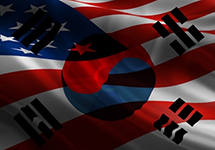Scott Snyder
Toby Dalton
Miles Pomper
March 27, 2015
Benefits of the Agreement

Image courtesy of ForeignPolicyBlog.com.
Korean and American negotiators are on the verge of concluding a new bilateral nuclear cooperation agreement to replace the current outdated one, which has been in place since 1974. This new agreement undoubtedly will be criticized by some in Korea because it does not give Seoul unconditional approval to enrich uranium or reprocess spent fuel. But such narrowly focused criticism is misplaced, for it overlooks the importance of the agreement to Korea’s energy security and the future of its nuclear program.
Judging the new nuclear cooperation agreement solely on single issues—such as the desire of some in Korea to pursue so-called pyroprocessing technology—obscures the very broad benefits it delivers to both Korea and the United States. It will satisfy President Park’s goals to enhance cooperation in assuring Korea’s fuel supply, managing nuclear waste and promoting exports of South Korean nuclear power plants. It also will enable collaboration in the areas of safety, scientific research, and global nuclear nonproliferation policy. In some respects, the bilateral nuclear cooperation agreement functions as a load-bearing beam, supporting the entire infrastructure of US-ROK nuclear partnership.
Nuclear Safety
US-ROK cooperation on nuclear safety is currently the most valuable dimension of nuclear partnership between the two countries that is enabled by the nuclear cooperation agreement. Though such collaboration is probably underappreciated, the recent debate about re-licensing the Wolsong nuclear power station demonstrates that the safe operation of nuclear reactors is arguably the most important issue for the Korean public as they evaluate dependence on nuclear power. Approval of future construction of nuclear facilities in Korea increasingly will turn on whether local residents believe the facilities can be operated safely.
The US Nuclear Regulatory Commission (NRC), the Korean Institute of Nuclear Safety and the Korean Nuclear Safety and Security Commission, maintain very strong ties, sharing advice on regulation and maintenance of protocols that are critical to the safe operation of nuclear reactors. In the event of a nuclear accident in Korea, the NRC would likely provide critical advice on crisis management and management of consequences of an accident, in the same way that the NRC’s advice was critical to Japan’s nuclear operators and regulators after the 2011 Fukushima accident.
The NRC also provides consultative advice to its Korean counterpart organizations so as to prevent nuclear accidents in Korea. In light of the Sewol tragedy and the earlier scandal involving falsely-certified nuclear reactor parts, this is a relationship that arguably should be strengthened. The regulatory capacity and oversight functions of Korea’s nuclear infrastructure need to be buttressed in order to assure the safe operation of Korean nuclear plants.
Scientific Collaboration
In addition to facilitating critical cooperation on nuclear safety, the nuclear cooperation agreement provides a framework that enables scientific cooperation, for instance, on methods for storing spent fuel, joint development of next generation nuclear reactor technologies, and production of isotopes for nuclear medicine. Most immediately, Korea must find safe and effective ways of storing spent fuel beyond the on-site facilities that are forecast to reach full capacity by 2024. The United States too faces a growing spent fuel management challenge, and both countries have incentive to work together to find solutions to interim and long-term storage problems.
Worldwide Influence
In the future, the US-ROK nuclear partnership will increasingly have a global dimension. For both commercial and political reasons, Korean reactor exports to the United Arab Emirates and other future customers are more attractive when US firms are involved. The nuclear cooperation agreement ensures that companies like Westinghouse can continue to partner with Korean nuclear industry in such projects. Moreover, Korea also benefits from having its nuclear designs certified by the NRC, something which the NRC is now considering with Korea’ s innovative APR-1400. In essence, NRC design certification provides a “good housekeeping” seal of approval that reassures potential foreign customers about the safety of the reactors.
Korea’s nuclear safety, technology development, and international leadership in the nuclear sector have been enabled by strong and enduring cooperation with the United States over the last 40 years. Critics of the new nuclear cooperation agreement may charge that it compromises Korea’s energy security and independence over its nuclear power program, but such a narrative misses the important point that Korea’s program is inextricably linked to America’s. The new nuclear cooperation agreement will carry the mutual benefits of this partnership well into the future.
Scott Snyder is senior fellow for Korea Studies at the Council on Foreign Relations, Toby Dalton is co-director of the Nuclear Policy Program at the Carnegie Endowment for International Peace, and Miles Pomper is senior research associate at the James Martin Center for Nonproliferation Studies. Together they are writing a report on the future of US-ROK nuclear energy cooperation. The opinions expressed are their own and do not represent positions of their respective institutions.
